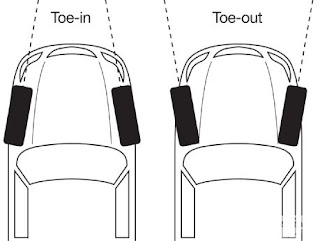 |
| A Mitsubishi 3000GT Receiving an Alignment |
First things first, why does alignment matter? If a vehicle's suspension is aligned properly, it should travel perfectly straight down a flat road without input from the driver (assuming you aren't experiencing violent torque steer - a topic we'll save for another post). Besides rolling straight and true, an aligned suspension allows for even tire contact with the ground and reduced tire wear. So what aspects of suspension alignment provide for this excellence in vehicle ride and handling?
 |
| Universal Coordinate System for a Vehicle |
 |
| Vehicle Toe - Birds Eye View |
 |
| Vehicle Camber |
As shown in the figure below, if a single wheel has toe-in or toe-out, the vehicle can steer in that direction without driver input. This scenario will require the driver to provide steering input in the opposite direction to keep the vehicle traveling straight.
If the alignment shop says that 'toe' was adjusted, this is what they are talking about. Every production car that the author can think of has adjustments for toe through the use of tie-rod ends.
Camber. A properly aligned street car should rest without camber. Camber is rotation of the wheel relative to the x-axis (see figure above). A sign of out-of-adjustment camber is tire wear along the tread edges. Uneven tire wear happens because the weight of the vehicle is resting along either the inside (negative camber) or the outside (positive camber) of the tire. If you could imagine, not utilizing the entire surface patch of the tire can also show itself with decreased traction - especially in wet conditions.
Most production vehicles have camber adjustment for the front wheels, but this is increasingly going away as a result of cost savings by the OEMs. Few, if any, vehicles allow for camber adjustment of the rear wheels - although 'camber plates' can be purchased in the aftermarket. Two reasons for out of whack camber are:
- The vehicle has been lowered resulting in negative camber.
- The vehicle has been in an accident (crash, pothole or otherwise) resulting in negative camber.
 |
| Vehicle Caster |
Due to vehicle kinematics, which is a topic for another time, positive caster results in a vehicle which is more stable and less likely to wander on the road. The detriment of increased positive caster is increased steering weight, which is offset with power steering.
When inspecting a used vehicle for purchase the author prefers, along with other checks, putting the vehicle on an alignment rig (see first figure). If the vehicle is at stock height and camber is beyond adjustment and out of specification, it has likely been in an accident. If the caster is out of specification, remember this cannot be adjusted and is another sign the vehicle may have been in an accident.
-Axle

This is a wonderful article. Great visuals! I really appreciate them. I learn a lot better with visuals. I don't know much about cars and alignment or vehicle terminology, but, just admiring all the information and how you organized it, makes it all a whole more attractive for me to learn. Thxs! http://www.alignmentcenterak.com/brake-repair
ReplyDelete